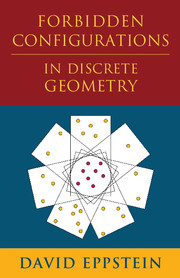'David Eppstein has managed to unify a huge swath of research on planar point sets through monotone properties and forbidden configurations. For example, finding grid points that avoid the obstacle of a 3-point line is a century-old problem still not entirely resolved. The author’s unification naturally uncovers research lacuna, several of which he fills, while others are formulated as sharp new open problems. This rare synthesis of previous work will reinvigorate and redirect the field.'
Joseph O’Rourke - Smith College, Massachusetts
'David Eppstein takes us on an adventure tour to the study of point configurations in Discrete Geometry. It visits many different topics, connected by the original viewpoint of 'forbidden configurations'. This is interesting, instructive - and fun!'
Günter M. Ziegler - Freie Universität Berlin
'This unique volume collects and unifies almost a century of work on point configurations on the plane, and their properties that depend on whether each subset of three points is oriented clockwise, oriented counterclockwise, or collinear. Beginning with the Happy Ending Theorem, the author takes us through entertaining problems and into computational geometry. A delight to read as well as a persuasive case for the method of forbidden configurations, the book will be a valuable addition to the library of any discrete or computational geometer.'
Peter Winkler - Dartmouth College, New Hampshire
'This is a fun read on certain topics in discrete and computational geometry. It begins with 'A Happy Ending' and ends with 'Only the Beginning'. Eppstein’s journey through various problems of pointset configurations offers a new view of the subject even to experts of the field. Recommended to everyone who likes geometry and computer science.'
Jozsef Solymosi - University of British Columbia
'David Eppstein has brought the weight of his formidable expertise and expositional talents on the simplest of shapes: points and lines. He gently guides the reader through a vast array of fascinating topics, their greatest hits to the state-of-the-art. This lovely book will be found on the shelves of mathematicians and computer scientists for many years to come.'
Satyan Devadoss - University of San Diego
'Erdős's many beautiful, notoriously difficult geometric problems on finite point configurations led to the birth of a new discipline: combinatorial geometry. The field gained additional significance in the 1980s, when it was discovered to be relevant to basic questions in computational geometry. Eppstein's elegantly written and illustrated book takes a fresh algorithmic look at the theory of forbidden geometric patterns. It can be read by specialists as a survey, but it can also serve as an excellent textbook for an introductory course on point configurations.'
János Pach - École Polytechnique Fédérale de Lausanne and Rényi Institute, Budapest
'There is a lot to like about this book, as Eppstein does a good job of introducing the material to his readers … A reader who sticks with Eppstein will learn a lot about this exciting area that lies on the border of mathematics and computer science.'
Darren Glass
Source: MAA Reviews
'The result is a first-class treatment: Eppstein deftly sells the subject to the uninitiated, yet carries it to depths experts will appreciate. A generous supply of diagrams gracefully projects many ideas, and the professional-quality design makes the reading experience a pleasure. Summing Up: Highly recommended.'
D. V. Feldman
Source: Choice
'The book is a great read. It is a valuable addition to the library of any discrete or computational geometer. Moreover, it can also serve as an excellent textbook for an introductory course on point configurations.'
László Szabó
Source: MathSciNet
‘This book is distinguished by a number of attractive features. Perhaps most prominent is its strong unity of approach. The first 7 chapters establish a coherent foundation and language for expressing and investigating the subjects studied in the remaining 10 … Another is its clarity of presentation and reader-friendliness. In most chapters the author adopts the strategy of introducing the topic in terms of an easily-understood problem that is accessible to virtually any reader … If you have any interest in learning about this field, I highly recommend this book.’
Frederic Green
Source: SIGACT News



